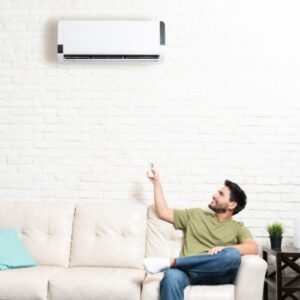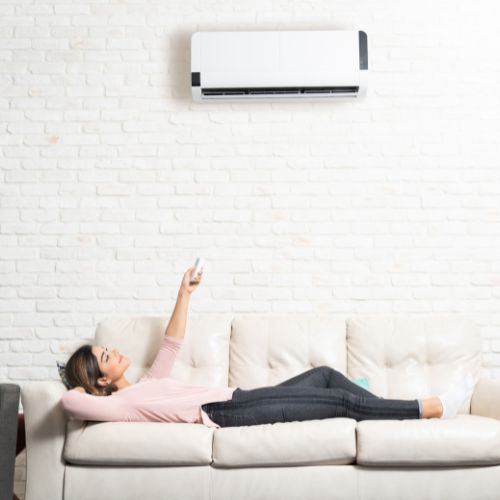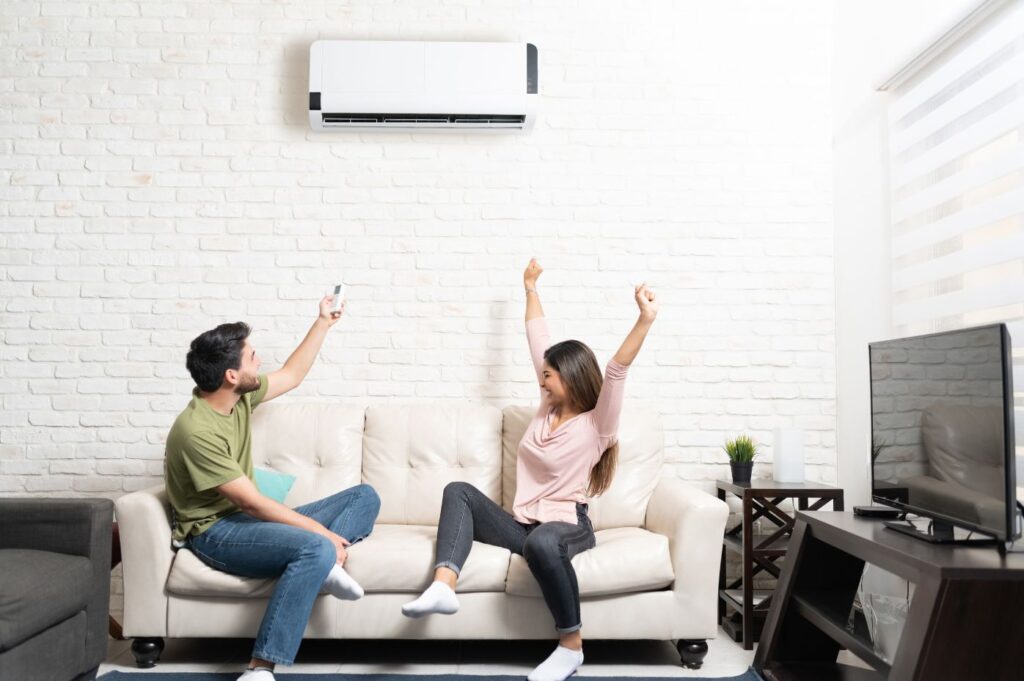
Mini-split systems, also known as ductless air conditioners or heat pumps, are a popular HVAC solution for both residential and commercial spaces. Unlike traditional HVAC systems that use ductwork to distribute heated or cooled air throughout a building, mini-split systems provide targeted heating and cooling to individual rooms or areas.
So, how do mini-split systems work? It’s quite simple. A mini-split system consists of two main components: an outdoor unit and one or more indoor units. The outdoor unit houses the compressor and condenser, while the indoor units contain the evaporator and air handler. These units are connected by refrigerant lines that circulate the refrigerant between them.
When the system is in cooling mode, the indoor unit’s evaporator absorbs heat from the air in the room, cooling it down. The absorbed heat is then transferred to the outdoor unit, where it is expelled into the surrounding air.
In heating mode, the process is reversed. The outdoor unit absorbs heat from the outdoor air and transfers it to the indoor units, where it is released to warm up the room. The ability to provide both heating and cooling is one of the major advantages of mini-split systems.
Additionally, these systems are highly efficient, as there is no need for ductwork, which can result in energy loss. They also offer flexible installation options, allowing for easy retrofitting or adding cooling and heating to specific areas without the need for extensive renovations. With their compact size and versatile functionality, mini-split systems are a convenient and effective choice for achieving optimal comfort in any space.
The Benefits of Installing a Mini-split System in Your Home
Installing a mini-split system in your home comes with a plethora of benefits. One of the main advantages is the flexibility it offers in terms of zoning. Unlike traditional HVAC systems that cool or heat the entire house, mini-split systems allow you to control the temperature in individual rooms or zones. This means you can save energy and money by only heating or cooling the areas that are being used rather than wasting energy on empty spaces.
Another benefit of mini-split systems is their compact size and easy installation. These systems consist of two main components – an outdoor unit and one or more indoor units. The indoor units can be mounted on the wall or ceiling, taking up minimal space and ensuring a sleek appearance. Additionally, the installation process is relatively simple, making it a viable option for both new constructions and existing homes. With no complex ductwork required, installation time and costs are significantly reduced.
How to Choose the Right Size Mini-split System for Your Space
When it comes to choosing the right size mini-split system for your space, there are a few key factors to consider. First and foremost, you’ll need to determine the total square footage of the area you want to cool or heat. This can be easily done by measuring the length and width of the room and multiplying the two numbers together.
Once you have the square footage, you’ll need to match it to the appropriate cooling or heating capacity of the mini-split system. This is measured in British Thermal Units (BTUs) and can range from 6,000 BTUs for a small room up to 36,000 BTUs for a larger space. It’s important to choose a system that is powerful enough to effectively cool or heat your room but not so powerful that it’s overkill and energy-wasting.
Keep in mind that other factors, such as insulation, ceiling height, and windows, can also impact the size of a mini-split system you’ll need. Consulting with a professional HVAC specialist can help ensure you choose the right size system for your specific needs and maximize its efficiency and performance. As a general rule of thumb, it’s better to slightly undersize a system than to oversize it, as an oversized unit may short cycle and lead to higher energy bills.

Common Issues and Troubleshooting Tips for Mini-split Systems
Mini-split systems are generally reliable and easy to maintain, but like any appliance, they can experience issues from time to time. The first issue you are likely to experience with this system is uneven cooling or heating, which happens when certain areas of your home are not receiving the same level of comfort as others; it could indicate a problem with air distribution. When this happens, check for any blockages in the vents or obstructions around the indoor or outdoor units. Additionally, make sure the air filters are clean and replace them if necessary.
It should also be noted that mini-split systems are designed to operate quietly, so if you hear unusual noises such as rattling, buzzing, or grinding, it could be a sign of a problem. These noises may indicate loose components, damaged fan blades, or a malfunctioning compressor. In such cases, it’s best to contact a professional technician to diagnose and repair the issue. Remember, if you are unsure about any troubleshooting steps or if the problem persists, it’s always recommended to seek the assistance of a qualified HVAC technician. As for which HVAC technicians in LA are best suited to take care of your mini-split system, just give our team at HVAC in LA a call.
DIY Installation vs. Professional Installation for Mini-split Systems
When it comes to installing a mini-split system in your home, you may be wondering whether you should tackle the project yourself or hire a professional. There are benefits to both options, so it’s important to weigh the pros and cons before making a decision. For those who are handy and have experience with electrical work, a DIY installation can be a cost-effective way to get the job done. However, it’s important to note that installing a mini-split system requires a certain level of technical knowledge and skill. You’ll need to properly mount the indoor and outdoor units, connect the refrigerant lines, and wire the system correctly. If you’re not comfortable with these tasks or if you’re unsure about the electrical requirements, it may be best to leave the installation to the professionals.
Hiring a professional for your mini-split system installation ensures that the job is done safely and correctly. HVAC technicians have the expertise and experience to handle the installation with ease. They will ensure that the system is properly sized for your space, that all components are installed correctly, and that everything is in compliance with local building codes. Additionally, professional installation often comes with a warranty, providing peace of mind knowing that any issues that may arise will be addressed by the experts.
Overall, the decision between DIY installation and professional installation for your mini-split system will depend on your comfort level with electrical work, your knowledge of HVAC systems, and your willingness to invest time and effort into the project. It’s important to consider the complexity of the installation and the potential risks involved. If you’re unsure, it’s always best to consult with a professional to ensure a successful installation and maximize the performance of your mini-split system. If you’re in search of the best professional services in Los Angeles, HVAC in LA is the right team for the job.

Contact HVAC In LA Today
Frequent Asked Questions
mini-split systems, also known as ductless air conditioners, consist of an indoor unit and an outdoor compressor. They work by transferring heat from inside the room to the outside, providing cooling in summer and heating in winter.
mini-split systems offer several benefits, including energy efficiency, flexibility in zoning, improved indoor air quality, quiet operation, and easy installation compared to traditional HVAC systems.
To determine the right size mini-split system, consider the square footage of the area you want to cool or heat. It’s best to consult with a professional to ensure you choose the appropriate size for your specific needs.
Common issues with mini-split systems include refrigerant leaks, frozen coils, strange odors, or issues with the remote control. Troubleshooting tips may include checking for leaks, cleaning or replacing filters, resetting the system, or contacting a professional for repairs.
mini-split systems are highly energy efficient compared to traditional HVAC systems. They allow for individual temperature control in specific zones, reducing energy waste. Additionally, their advanced technology and inverter compressor technology contribute to cost savings on utility bills.
Modern mini-split systems often come with smart features such as Wi-Fi connectivity, smartphone apps for remote control, voice control compatibility with home assistants, and advanced sensors for optimal comfort and energy-saving capabilities.
While some may choose to install a mini-split system themselves, it is often recommended to opt for professional installation. Professionals have the expertise and knowledge to ensure proper installation, which can prevent potential issues and maximize system performance.
To keep your mini-split system running smoothly, regularly clean or replace air filters, check for any blockages around the outdoor unit, ensure proper airflow, clean the indoor unit’s coils, and schedule annual maintenance with a professional technician.


